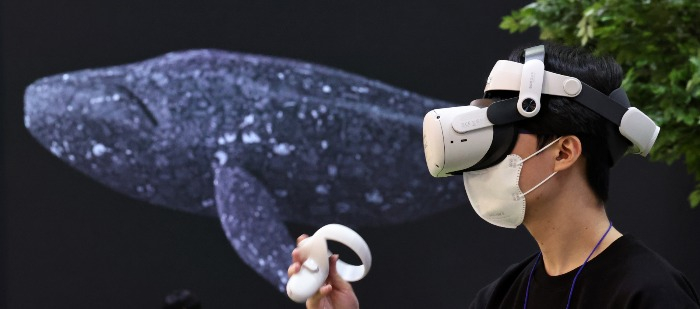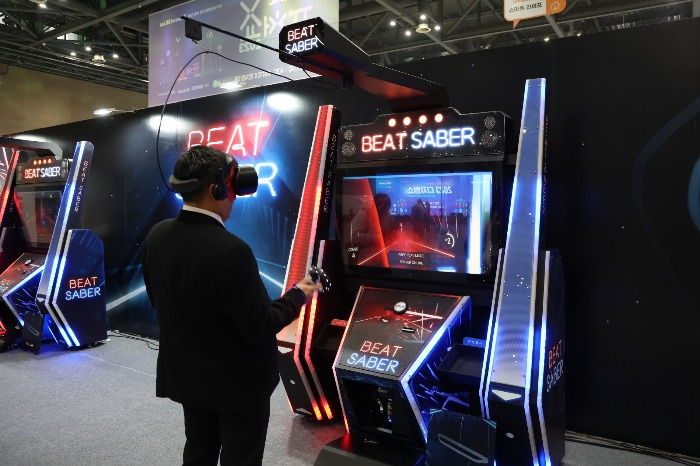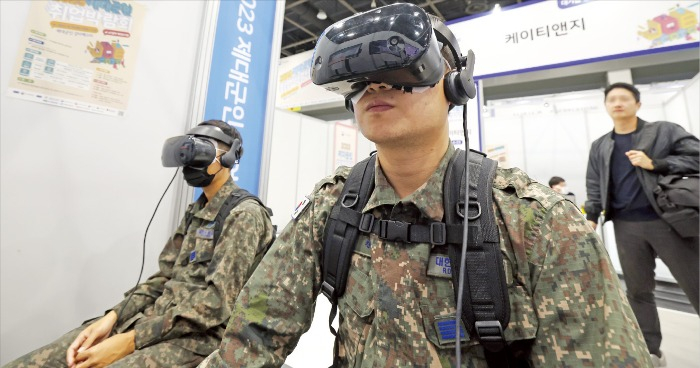Electronics
Samsung, LG accelerate push into virtual reality displays
Samsung Display is preparing to produce OLEDoS, or OLED on silicon, in 2024
By Nov 10, 2023 (Gmt+09:00)
2
Min read
Most Read
LG Chem to sell water filter business to Glenwood PE for $692 million


Kyobo Life poised to buy Japan’s SBI Group-owned savings bank


KT&G eyes overseas M&A after rejecting activist fund's offer


StockX in merger talks with Naver’s online reseller Kream


Mirae Asset to be named Korea Post’s core real estate fund operator



South Korea’s two leading display makers Samsung Display Co. and LG Display Co. are in the early stages of developing screens for extended, or virtual reality devices.
Now they are accelerating their push into the burgeoning market after Google Inc. unveiled its virtual reality (XR) headset Vision Pro equipped with Sony Corp.’s organic light-emitting display (OLED) early this year, according to industry officials on Friday.
Samsung Display is preparing to produce OLEDoS, or OLED on silicon, next year as its affiliate Samsung Electronics plans to launch its first XR device in December 2024.
If it goes as planned, it will become the first South Korean company to produce OLEDoS.

To secure Samsung Electronics Co.'s semiconductor processing technology, Samsung Display recently paid 39.1 billion won ($30 million) to use its patented semiconductor technology.
OLEDoS refers to OLED made on silicon, not on glass, unlike conventional OLED panels. It is ultra-small with a diagonal length of about 3.3 cm.
The display features a higher pixel density than conventional displays, meaning an enhanced resolution even on a small and lightweight screen.
Microdisplays produced in this way display a screen enlarged tens to hundreds of times close to the eyes.
The XR device market is predicted to grow to 187 million units by 2029. That compares to 21.4 million units in 2023, a 56% jump from the previous year, according to research firm Omdia.

Samsung Display’s first-generation OLEDoS will adopt a WOLED-CF architecture, which uses a white OLED emission layer with filters in red, green and blue.
It will then develop a next-generation OLEDoS in collaboration with the US-based OLED microdisplay developer eMagin, which it acquired at $218 million in May of this year.
LG DISPLAY
LG Display has joined forces with SK Hynix Inc. to develop OLEDoS wafers for XR devices. LX Semicon Co., a fabless semiconductor designer, is in charge of the wafer designs.
LG Display in January unveiled a prototype of OLEDoS mounted on XR headsets at CES 2023, the world’s largest IT and home appliance exhibition.
It is known that LG has no immediate plan to commercialize it.
IN SHORT SUPPLY
OLEDoS for Google Vision Pro was designed by Sony and produced by TSMC, the world’s largest semiconductor foundry company.
Market observers say displays for XR devices are in short supply because they require ultra-fine processes in nanometer (㎚) units.
In February this year, TM Roh, head of Samsung Electronics' Mobile eXperience (MX) division, said it is going to change the future of the mobile world by sharing XR technologies with Qualcomm and Google.
Write to Ye-Rin Choi at rambutan@hankyung.com
Yeonhee Kim edited this article.
More to Read
-
 Korean chipmakersSamsung takes steps toward XR device processor chips
Korean chipmakersSamsung takes steps toward XR device processor chipsMay 28, 2023 (Gmt+09:00)
2 Min read -
 Tech, Media & TelecomLG Innotek targets XR device market with new substrate
Tech, Media & TelecomLG Innotek targets XR device market with new substrateFeb 15, 2023 (Gmt+09:00)
2 Min read -
 Tech, Media & TelecomSamsung’s next frontier: XR in partnership with Qualcomm, Google
Tech, Media & TelecomSamsung’s next frontier: XR in partnership with Qualcomm, GoogleFeb 02, 2023 (Gmt+09:00)
3 Min read -

Comment 0
LOG IN


